Sons of Death, servants of Kali: the secret sect of the Tug-stranglers
The most notorious sophisticated killers were the Indian thugs, who were "the most bloodthirsty bandits in the history of mankind." In 1812 alone, about 40,000 people died at their hands.
Since about the 12th century, bands of Tugs in central India have been robbing caravans and killing travelers. The victim was strangled by throwing a rope or scarf around the back of his neck, and then buried with a ritual pick-hoe or thrown into a well. The exact number of victims is not known for certain, but the Guinness Book of World Records puts them at the expense of two million deaths in just one century.
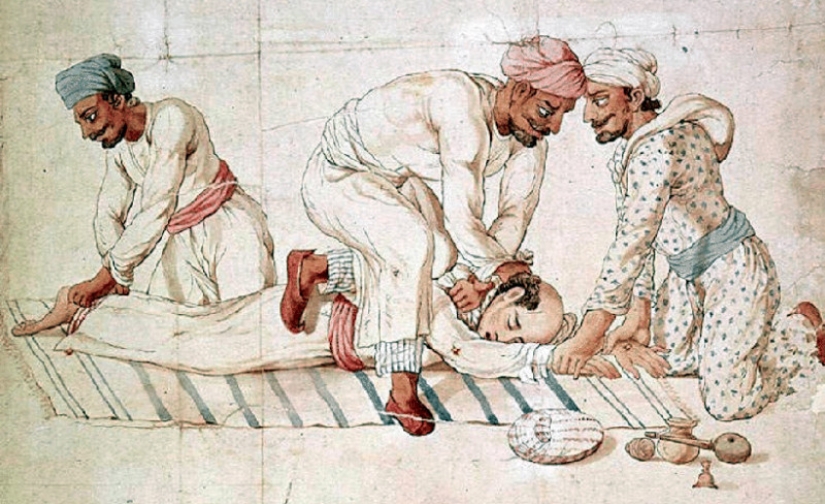
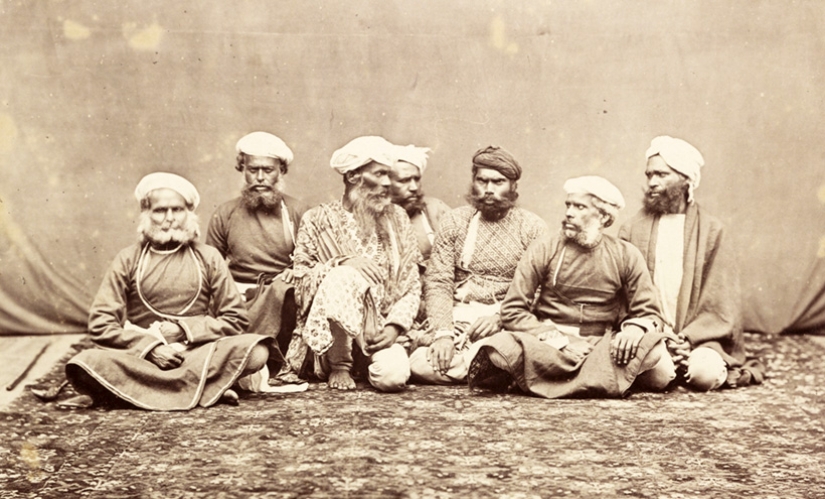
Thugs (or thugs, thugs, phasingars, stranglers, from the English thuggee) — medieval Indian bandits and robbers who devoted themselves to the service of Kali. Photo from 1894.
Becoming a tug wasn't easy — it's a long, complicated process. Boys were admitted to the sect when they were 10-12 years old. For the most part, the candidates were close relatives of the strangler.
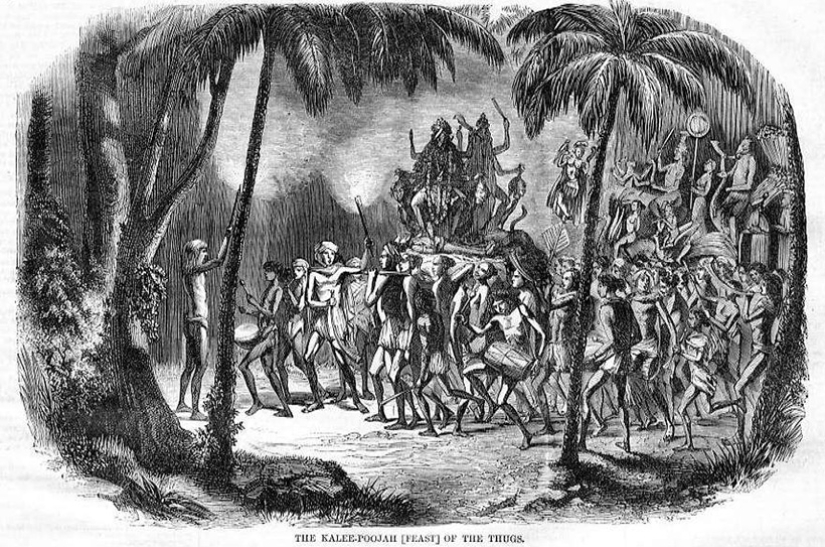
To become a true tug, it was necessary to go through quite a long path of initiation. At the beginning of their journey, the members of the sect performed the duties of a gravedigger. After a few years, having grown up, they were allowed to explore, then became touts. However, each time, their skills had to be improved. And dedication was the main condition. Those who inadvertently or intentionally revealed their membership in the Tug group were immediately severely executed.
Only after passing through all the stages of Kali service could the tug be admitted to initiation into bhuttotagi, i.e., stranglers. Often by this age they were already quite respectable people, even the fathers of families. In everyday life, any Indian could be a servant of the goddess of death. Merchants, officials, peasants-they, the tugs, were in all areas of human life. The permission to serve in secret was inherited, as were the ties to the tugs of other groups throughout the country. India.
The young strangler had to kill as many victims as possible, and do it in the shortest possible time. At the same time, he was forbidden to strangle women, lepers, crooked, lame, and generally ugly people, as well as washerwomen and representatives of certain selected castes, who were protected by the goddess Kali. Women, by the way,were protected from murder only if they traveled alone, without a male patron.
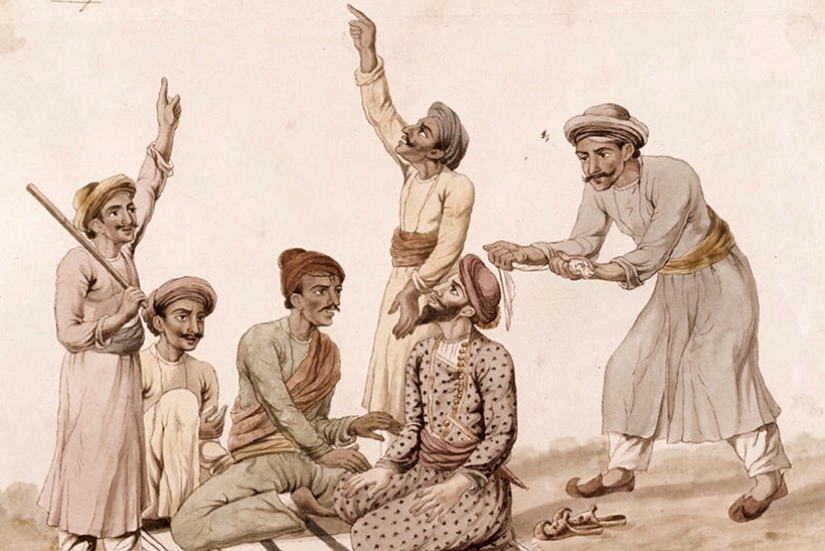
Thevenot, a famous French traveler of the seventeenth century, complained in his letters to his homeland that all the roads from Delhi to Agra were teeming with these "deceivers". He wrote:
The Tug gangs usually went out on the high road after the rainy season, in the fall. Until the following spring, only one of the gangs (and there were several hundred of them all over the country) could strangle more than a thousand people. Sometimes their victims were lone travelers, at other times-whole groups of people who passed into the other world in the blink of an eye. The Tug never left any witnesses alive, so even dogs, monkeys, and other animals belonging to the slain were destroyed.
The preparations for the murder were always routine. The gang would set up camp near a town or village and send a few of its more intelligent members to roam the streets and visit the shops. As soon as they saw a small group of travelers, they immediately found a common language with them and suggested that they continue to travel together. If the simpletons agreed, their death was not far off.
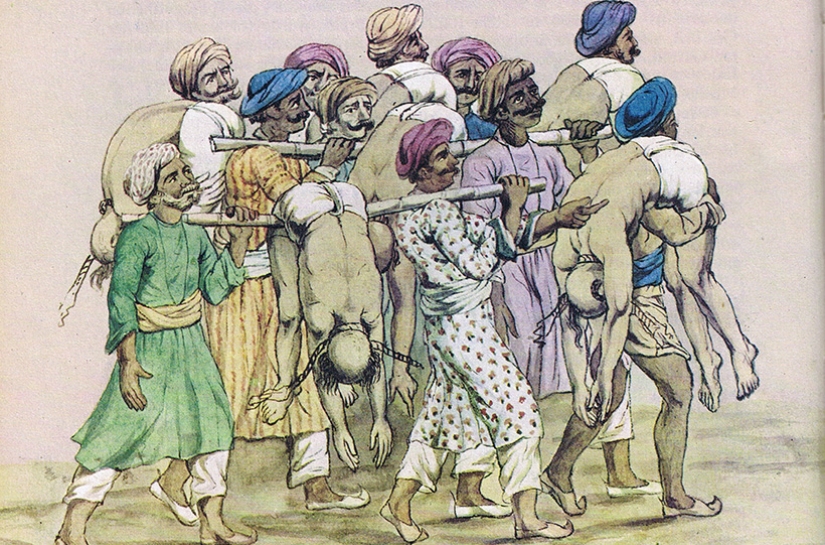
The sacrifice was performed by strangulation, bloodlessly. The murder weapon was a silk ribbon 90 cm long and 2.5 cm wide — a rumal. The technique of covering the neck with a rumal has been perfected. The lightning throw of the end on which the knot was tied could be made from the front, from the side, but-most often-from behind the victim.
Having intercepted the end wrapped around the neck, tug performed a cross-strangulation, from which, as experts in martial arts admit, it is already impossible to escape. Perhaps this is the only military equipment that has passed from a religious ritual to modern life. It was adopted by special forces specialists and became an applied element of their combat skills.

Miniatures from the series "Portraits of famous Indian Tugs" by Charles Wade Crump, 1851-1857.
After each kill, the Thugs would sit on the edge of a large carpet that was spread out on the ground and look east. Their leader said a short prayer and handed each participant of the operation a piece of "sacred" yellow sugar. The stranglers were convinced that once someone tried it, they would never change their business. In all likelihood, the sugar contained some narcotic substance.
Here, on the spot, the loot was divided. The gravediggers stripped the dead of their clothes and, after making several deep incisions on the corpses to make it easier for Kali to drink blood, quickly buried the bodies of the robbed. When the ground was hard, the grave was dug shallow and a wooden stake was driven into the chest of the victim, holding the body at the bottom of the pit. The grave was covered with stones, and wild animals could no longer dig it up.
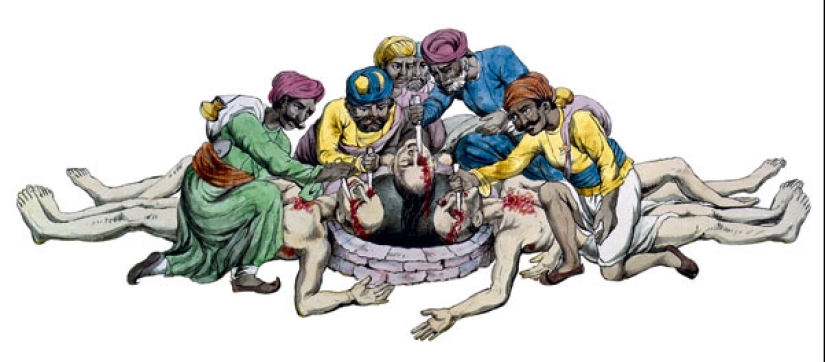
The Tugs pierce the eyes of their victims before dumping the bodies into the well. For the stranglers, this was a "control shot", which became a mandatory procedure for them after a man they thought was dead came to his senses in 1810 and escaped.
The adepts of the secret sect of the Tugs sincerely believed that, serving their powerful goddess, they were fulfilling a divine mission, destroying an excess of bred people. As a reward for such "service", they took the property of the dead. Seen in the "rat race" was doomed and shared the fate of its victims. If one of the members of the sect confessed to those in power or even to his relatives that he was a tug, he was also killed, and with his own rumal, which was then burned.
The Stranglers were not bandits in the usual sense of the word. They didn't kill people just for the loot. In accordance with an elaborate ritual, the tug sacrifices were dedicated to the dark and terrible goddess Kali.
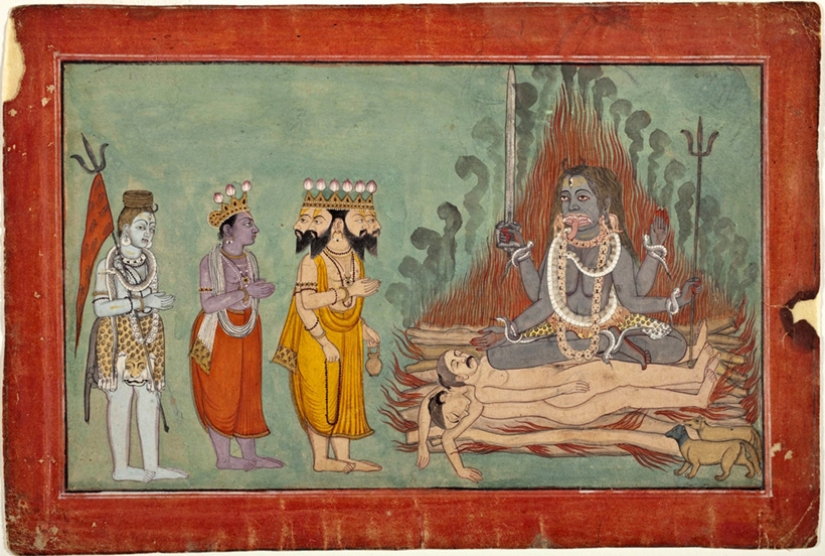
Kali, or Bovani (equally known in India by both names), was born, according to legend, from the burning eye in the forehead of the god Shiva. She came out of that eye, like the Greek Athena from the skull of Zeus, an adult and perfect being.
Kali represents evil spirits, enjoys the sight of human blood, prevails over pestilence and pestilence, directs storms and hurricanes, and always seeks destruction. She is presented in the most terrible image that the Indian imagination could create: her face is azure with yellow stripes, her eyes are fierce, her hair is loose, disheveled and bristly, standing like a peacock's tail, and intertwined with green snakes. She had her own temple, where people sacrificed domestic animals and birds to her, but her real priests were the thugs-the sons of Death, quenching the endless thirst of the bloodthirsty deity.
According to legend, Kali first wanted to exterminate the entire human race, with the exception, of course, of her loyal followers and admirers. Taught by her, they began to kill everyone with their swords. And so great was the destruction wrought by the Tugas, that the human race would soon have been cut off altogether, had not the god Vishnu intervened. All the blood spilled on the earth, he forced to reproduce new living beings and, thus, opposed the priests of Kali.
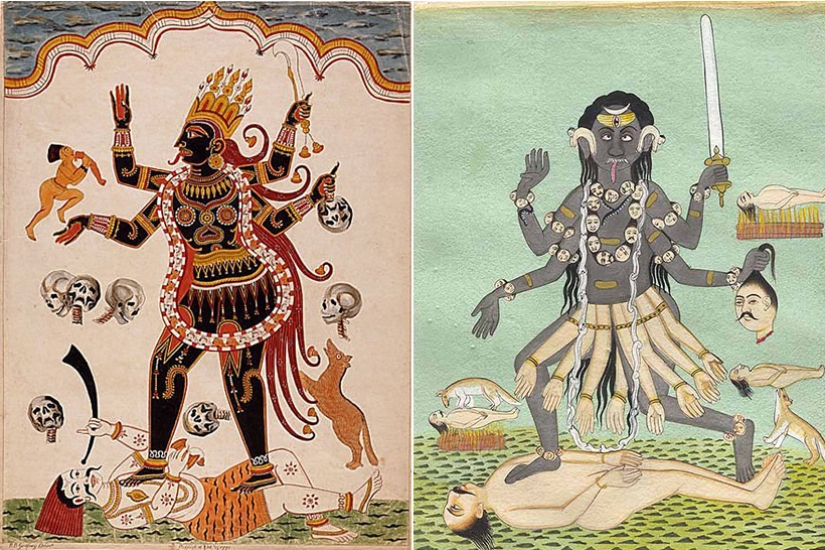
Then the bloodthirsty goddess went to the trick and told her followers only to strangle people. With her own hands, she made a human figure out of clay, breathed life into it with her own breath, and taught the Tugs to kill without spilling blood. And to prevent Vishnu from finding out about her cunning, she promised her priests that she would always hide the bodies of their victims and destroy all traces.
Kahlee kept her word. But one day one of the curious tugs wanted to know what the goddess was doing with the dead bodies, and waylaid her when she was about to carry away the body of the traveler he had killed. Noticing the curious man, Kali approached him and said:
And not always success will be on your side, sometimes you will become a victim of the unholy laws of light, which should be your eternal punishment. You will have nothing left but the knowledge I have given you and a higher mind. I will govern you from now on only through omens, which you should study carefully."
Since then, the Tug and began to attach special importance to various kinds of omens. They saw them in the flight of birds, in the habits of jackals, dogs, or monkeys. Before going out "on the case", they began to throw an axe in the air, and in which direction on the ground it fell with the ax handle, that's where the killers directed their path. If an animal crossed their path from the left side to the right, the Tugs considered it a bad omen and the expedition was postponed for a day.
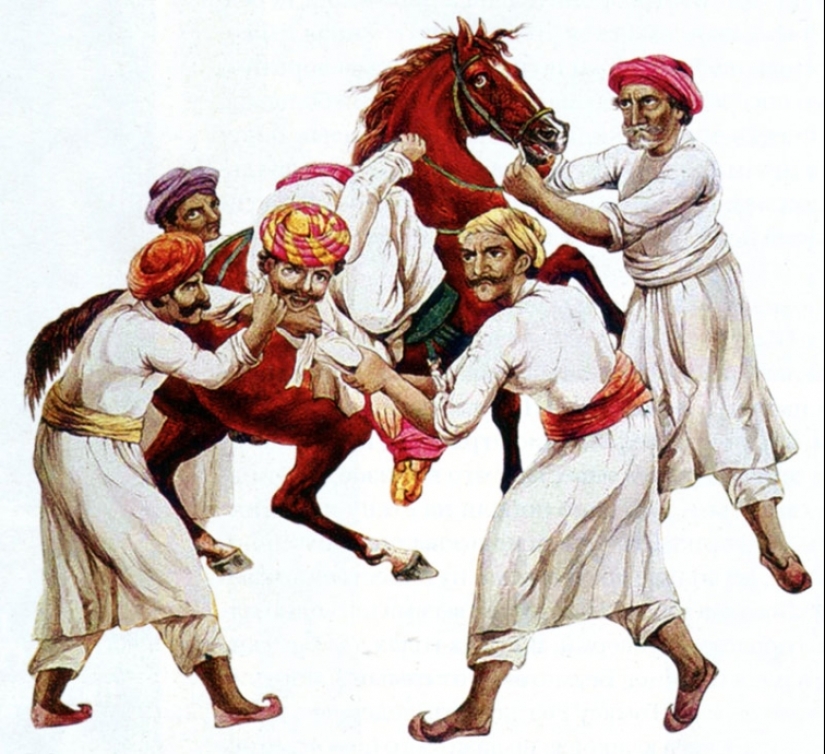
At first, the colonial English administration had no idea about anything. The Tug were very secretive and attacked mainly in the jungle and other deserted places. The victims were most often travelers. And since the movement around the country lasted for several months, then they did not immediately learn about the loss.
But the country was united, and horrific facts about the actions of the Tug ministers began to emerge. The biggest campaign to catch the ritual murderers was organized by Captain William Slimane, who studied their activities for several years. It turned out that the followers of the cult of Kali were several hundred thousand people, including high-ranking officials. So, the case of Maharaja formed the basis of the film about Indiana Jones.
Slimane was the first to realize the fundamental religious nature of the strangler cult — the murders were sacrifices intended for the dark mother, Kali. Because of their deep religious beliefs, the Tug were usually conscientious, honest, benevolent, and reliable. Slimane's assistant described one of the sect leaders as "the best person I've ever known." Many of the stranglers were rich people in positions of responsibility. Some of the money they looted was sent to local rajahs or officials.
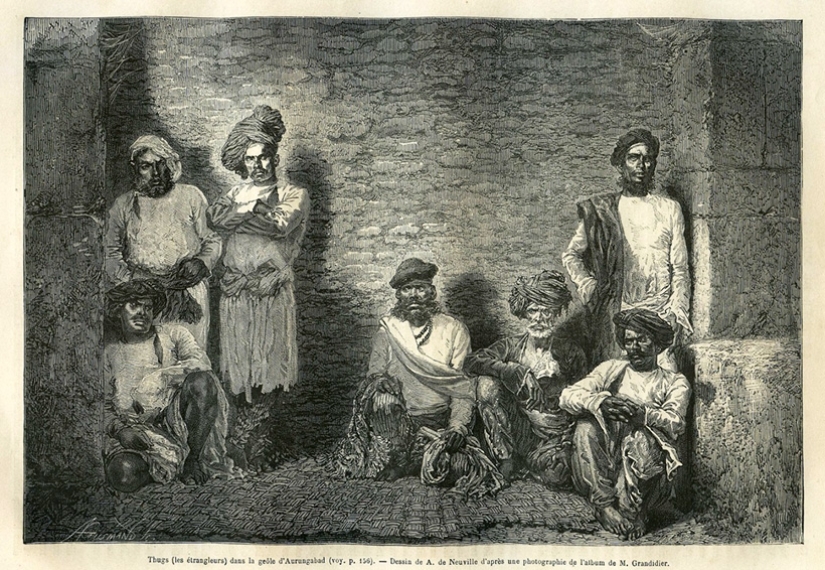
A group of Tugs in a prison cell. Unlike most of these types of drawings, this one seems to be made from nature and conveys not a romantic vision of the artist, but what the stranglers really looked like.
In total, Captain Slimane managed to get the conviction of more than three thousand robbers-stranglers. But thousands more bandits remained at large. At the same time, it should be borne in mind that each strangler could boast of killing at least 250 people during his "career".
When the Prince of Wales, the future King Edward VII of England, visited India in 1876, the Tug crimes were already on the wane. The prince was taken to a prison in Lahore, where he interviewed an elderly highwayman, whose life was spared after he gave evidence to the court and named his accomplices. The prisoner told the prince without a trace of emotion that he had sent 150 people to the other world.
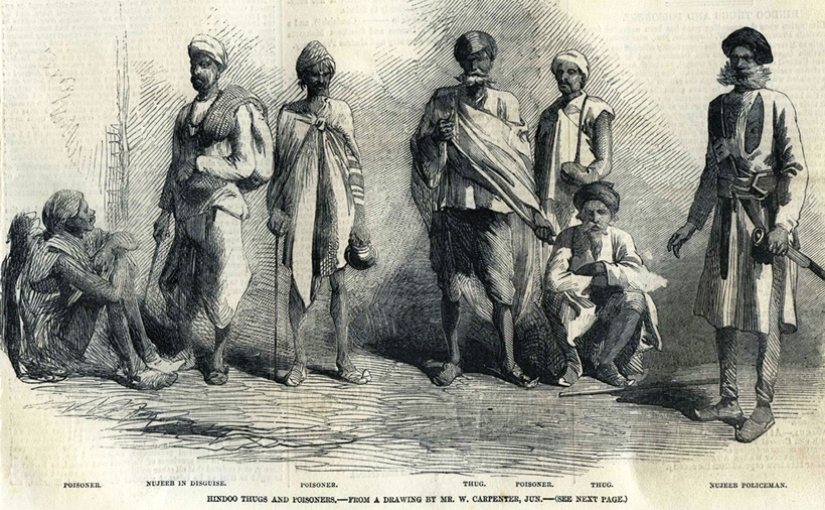
According to the historian William Rubinstein, between 1740 and 1840, the Tug killed 1 million people. The Guinness Book of World Records puts two million deaths on their account.
India is famous for the first and most large-scale serial killer in the history of mankind, a tug strangler named Behram. He was born in 1778 near Delhi. Among his peers, he stood out with a powerful physique, huge growth and incredible strength, so at the age of 12 he successfully committed his first "ritual" murder.
Like all the other members of the sect, Behram used a silk handkerchief-a garrote of the traditional yellow and white color. For "convenience", a few coins were tied at one end of the handkerchief, and this weight made it possible to wrap the noose around the victim's neck in the blink of an eye. Deftly creeping up behind, Behram threw a noose, deprived the unfortunate person of life and took his property, part of which he donated to his "patroness".
It is incredible, but in 50 years Behram strangled 921 people, which was proved at the trial. Fearing that the Thugs would try to save what they considered almost a demigod, the authorities sent Behram to the gallows immediately after the trial. He is officially listed in the Guinness Book of World Records as the largest serial killer in the history of mankind.
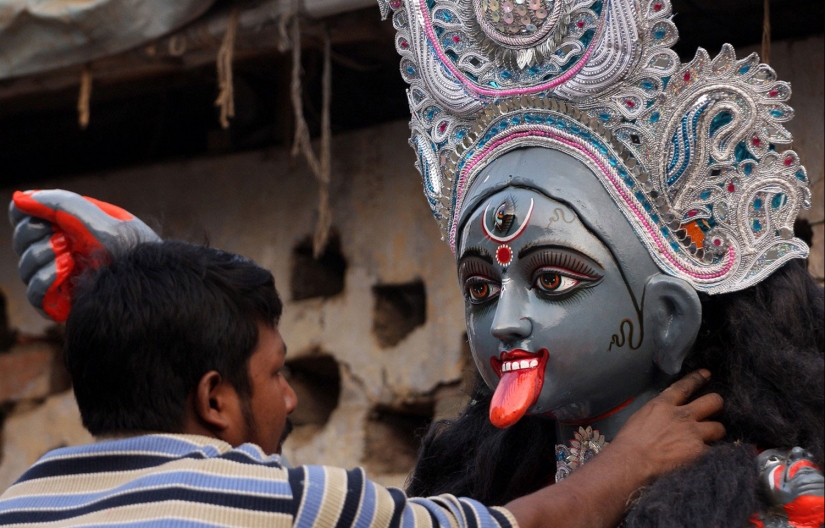
Stone statues of the goddess Kali have been preserved in India to this day. The locals still offer their sacrifices to them, as they did in the past for several centuries.
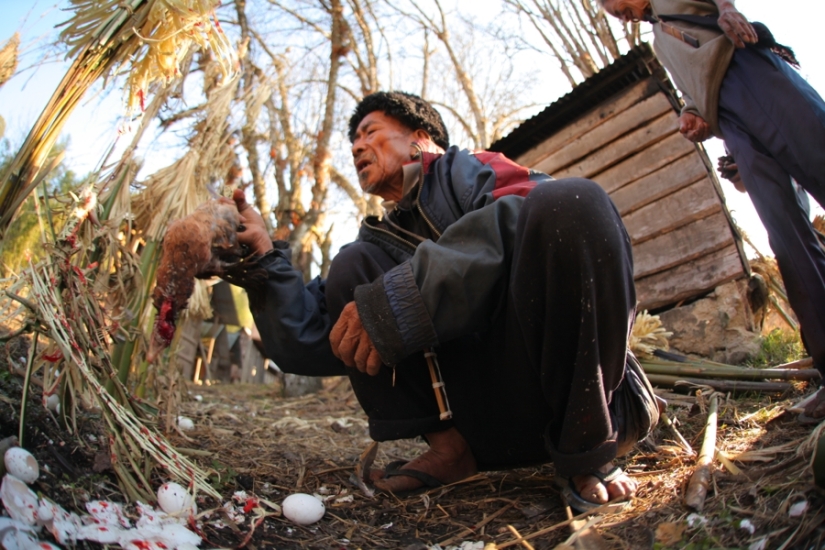
Every day at six o'clock in the evening, the modern tug is offered as a sacrifice of roosters. However, there are still reports of human sacrifice.
Keywords: India | Asia | Religion | History | Murder | Sect | 19th century
Post News ArticleRecent articles

Twitter user @FactBuffet collects interesting facts about everything. Today we bring to your attention another series of facts that ...

Aomori Prefecture in the north of the Japanese island of Honshu is an agricultural region famous for its delicious apples. In ...
Related articles

The Himalayas. Tibet. Something cosmic and ethereal sounds in the names. They attract visitors from all over the world. In front of ...

The Indochina Peninsula, located in southeast Asia, is a favorite place for tourists all over the world. Myanmar, Thailand, Laos, ...

If you have ever complained that there is not enough space for three people in the kitchen in your apartment, then it is better to ...

Imagine a baby vampire or a tiny zombie with glass eyes ... An artist from the USA Bean Shanine specializes in creating such ...